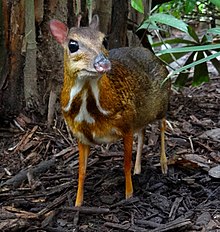| Chevrotain Temporal range:
| |
|---|---|

| |
| Lesser mouse deer (Tragulus kanchil) | |
| Scientific classification | |
| Domain: | Eukaryota |
| Kingdom: | Animalia |
| Phylum: | Chordata |
| Class: | Mammalia |
| Order: | Artiodactyla |
| Suborder: | Ruminantia |
| Infraorder: | Tragulina |
| Family: | Tragulidae H. Milne-Edwards, 1864 |
| Type genus | |
| Tragulus Brisson, 1762
| |
| Genera | |
Chevrotains, or mouse-deer, are diminutive, even-toed ungulates that make up the family Tragulidae, and are the only living members of the infraorder Tragulina. The 10 extant species are placed in three genera,[1][2] but several species also are known only from fossils.[3] The extant species are found in forests in South and Southeast Asia; a single species, the water chevrotain, is found in the rainforests of Central and West Africa.[4] In November 2019, conservation scientists announced that they had photographed silver-backed chevrotains (Tragulus versicolor) in a Vietnamese forest for the first time since the last confirmed sightings in 1990.[5][6][7]
They are solitary, or live in loose groupings or pairs, and feed almost exclusively on plant material.[4] Chevrotains are the smallest hoofed mammals in the world. The Asian species weigh between 1–4 kg (2–9 lb), while the African chevrotain is considerably larger, at 7–16 kg (15–35 lb).[8][9] With an average length of 45 cm (18 in) and an average height of 30 cm (12 in), the Java mouse-deer is the smallest surviving ungulate (hoofed) mammal, as well as the smallest artiodactyl (even-toed ungulate).[8] Despite their common name of "mouse deer", they are not closely related to true deer.
- ^ Wilson, D. E.; Reeder, D. M., eds. (2005). Mammal Species of the World: A Taxonomic and Geographic Reference (3rd ed.). Johns Hopkins University Press. ISBN 978-0-8018-8221-0. OCLC 62265494.
- ^ Groves, C.; Meijaard, E. (2005). "Intraspecific variation in Moschiola, the Indian chevrotain". The Raffles Bulletin of Zoology. Supplement 12: 413–421.
- ^ Farooq, U.; Khan, M.A.; Akhtar, M.; Khan, A.M. (2008). "Lower dentition of Dorcatherium majus (Tragulidae, Mammalia) in the Lower and Middle Siwaliks (Miocene) of Pakistan" (PDF). Tur. J. Zool. 32: 91–98. Archived from the original (PDF) on 28 September 2011.
- ^ a b Nowak, R.M., ed. (1999). Walker's Mammals of the World (6th ed.). Baltimore, MD: Johns Hopkins University Press.
- ^ Chappell, Bill (11 November 2019). "Silver-Backed Chevrotain, with Fangs and Hooves, Photographed In Wild for First Time". NPR. NPR.org. Retrieved 12 November 2019.
- ^ Nguyen, An (11 November 2019). "Camera-trap evidence that the silver-backed chevrotain Tragulus versicolor remains in the wild in Vietnam". Nature.com. Retrieved 12 November 2019.
- ^ "Tiny deer-like animal spotted after 25 years" (Video). CNN. 11 Nov 2019.
- ^ a b Fukuta, K.; Kudo, H; Jalaludin, S. (1996). "Unique pits on the erythrocytes of the lesser mouse-deer, Tragulus javanicus". Journal of Anatomy. 189 (1): 211–213. PMC 1167845. PMID 8771414.
- ^ "Hyemoschus aquaticus". Ultimate Ungulate. Retrieved 12 October 2010.